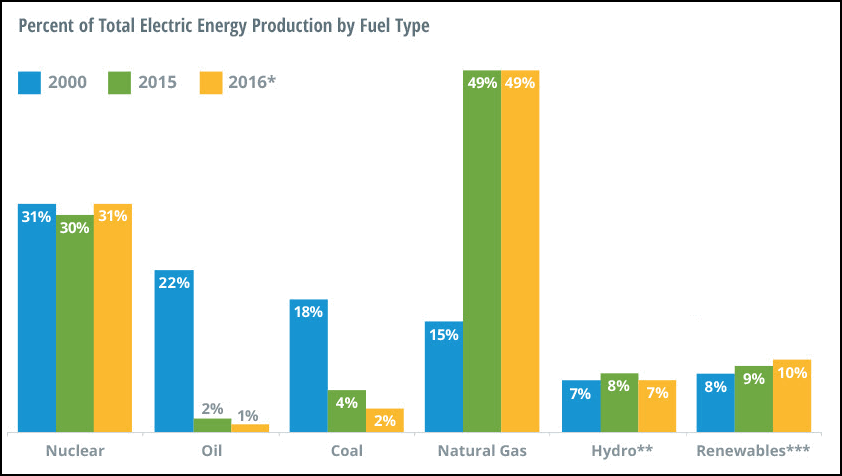Wholesale Competition – History [Download PDF]
On May 1, 1999, the New England ISO (ISO-NE) implemented a wholesale hourly energy market and new ancillary services markets. The market was redesigned in 2003 to include day-ahead and real-time markets. A forward-capacity market was established in 2008 to procure sufficient capacity three years in advance of an identified need.
The open, transparent wholesale electricity marketplace designed and run by ISO-NE stimulates strong competition among over 400 buyers and sellers and has attracted billions of dollars in private investment. The Forward Capacity Market has procured about 30,000 MW of generating capacity and approximately 3,000 MW of active demand response and energy efficiency (EE) to meet New England's needs in 2017 and replace retiring generators. This new generating capacity, mostly fueled by natural gas, has nearly eliminated regional generation by oil and coal (Figure 1) and substantially reduced regional emissions of sulfur dioxide, nitrogen oxides, and carbon dioxide (Figure 2).

Figure 2. Annual ISO-NE Regional Pollutant Emissions, 2001 and 2015. [source]
Retail Competition – History
Following on the heels of retail choice pilot programs conducted in 1996, the Massachusetts Department of Telecommunications and Energy issued an order in January 1997 officially opening retail markets to competition in 1998.This was amplified later that year when the governor signed HB5117 into law, requiring retail access by March 1998. The law requires that the existing investor-owned utilities be split up into three separate companies or separate operating units, consisting of distribution, transmission, and generating units. The distribution companies continue to be regulated monopolies with rates fixed by the Department of Public Utilities. For those consumers not switching to a competitive supplier, the law mandated a 10% rate cut immediately, followed by an additional 5% cut 18 months later. All investor-owned utilities (IOUs) were covered by the law. Participation by municipal utilities remains optional.
Stranded Costs
The Massachusetts restructuring law required distribution utilities to divest their generation facilities, either by sale or by transfer to an affiliated company. If a distribution utility opted to transfer its generation assets to an affiliate, the two companies had to be strictly separated, and distribution utilities are not permitted to sell electricity at retail except to provide their customers with default service. Each of the distribution companies divested their assets to only one company.
The 1997 legislation also established rules for the acceptable types of stranded utility investments that could be incorporated into a non-bypassable transition charge, which was collected by the distribution utilities over the course of ten years. Statewide stranded costs totaled approximately $9.7 billion and included costs for generation-related assets, nuclear shutdown and decommissioning assets, regulatory assets, purchased power contracts, and certain employee-related costs.
Consumer Protection
All competitive suppliers must be licensed to provide service to customers in Massachusetts. Licensing regulations require a supplier to show technical and financial capability.
A supplier may not switch a customer without the customer's prior authorization, either in the form of the customer's written consent or a customer oral statement. If it is determined that a customer was switched without his consent, the supplier must refund the difference between what the customer would have paid his previous supplier and the charges he paid to the supplier who switched his service. The supplier must also refund any reasonable expenses the consumer had to pay in switching back to his previous supplier, as well as refund to the previous supplier the revenue the previous supplier would have received from the customer if he had not been switched. In addition, the switching supplier will be subject to civil penalties and may be prohibited from selling electricity for up to one year.
The distribution utility cannot release proprietary customer information to an affiliate without written consent of the customer. Historical usage information will be provided to a supplier who has received customer authorization to initiate service.
Customer Billing
All customer bills must include separate line items for generation, transmission, and distribution charges. A customer will receive either one bill from the distribution utility for all electric charges, or two bills, one from the distribution utility for distribution-related charges and one from the generation supplier for generation and transmission charges.
In addition to presenting unbundled charges, the legislation required that each consumer bill contain a disclosure label including average price or price variability information, a description of the power sources used in generation, air emissions characteristics, labor practices characteristics, and a toll-free number for customer service. Competitive suppliers are also required to prepare a terms-of-service statement which includes information on pricing, contract, and billing procedures.
Renewable Resources
Massachusetts restructuring legislation required each distribution utility to collect a per-kilowatt-hour renewable energy surcharge to promote "the increased availability, use, and affordability of renewable energy."
Energy Efficiency
The enabling legislation also specified that the distribution utilities would continue to have the responsibility for implementing EE programs. The legislation also specified per-kilowatt-hour charges to fund these programs.
Consumer Choice Today
In mid-2000, the Massachusetts retail electricity market included 33 competitive suppliers. As of August 2017, a total of 29 competitive suppliers were active in Massachusetts, although not all suppliers have offerings in all service areas.
As of April 2017, fully 68% of electricity consumption in the state was delivered by competitive suppliers, with variations between rate classes as shown in Figure 3. The remaining 32% of electricity consumption is served by the default IOU.
Sources:
220 CMR 11.00: RULES GOVERNING THE RESTRUCTURING OF THE ELECTRIC INDUSTRY. [PDF]
Federal Trade Commission, Competition and Consumer Protection Perspectives on Electric Power Regulatory Reform: Focus on Retail Competition, Appendix A. September 2001. [PDF]
Commonwealth of Massachusetts, Electric Customer Migration Data.

